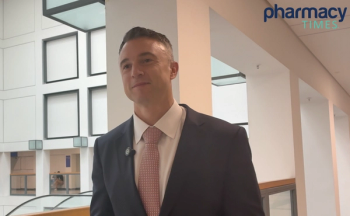
- May/June 2016
- Volume 7
- Issue 3
Adherence to Oral Oncolytics Requires a Clinically Integrated Approach to Specialty Pharmacy
Despite initiatives that help patients maintain adherence, health care providers still need to leverage their collective resources and work together to overcome this tremendous hurdle in cancer care.
THE FAST-GROWING ONCOLOGY DRUG PIPELINE has produced a number of new oral therapies meant, in part, to make treatment more convenient and manageable for patients.
Yet, despite the severity of their illness and the potential efficacy of a therapy, many patients fail to adhere to their specific treatment instructions. Adherence rates dip as low as 20% in some studies,1 indicating that many patients fail to receive the full benefits of their prescribed treatment. Although solutions exist to help patients navigate barriers to adherence, in order to address the problem on a large scale, health care providers—including physicians, oncologists, and specialty pharmacists—must leverage their collective resources and expertise to work together.
The oral oncolytics market grew significantly in recent years and now comprises about 25% of cancer medication therapies.2 That percentage is projected to increase, as the FDA approves 1 new oral oncolytic every 4 months.3 Unlike infused oncology regimens, which require patients to travel to a physician’s office or infusion centers, oral therapies enable patients to take their treatment at home.
However, the added convenience also shifts more responsibility to the patient, requiring compliance with specific instructions without the supervision of, or face-to-face interaction with, providers. Similar to other cases of nonadherence, a variety of reasons drive patients to become noncompliant with treatment instructions.
Patient Education and Communication
During infused oncology regimens for which patients travel to a care site, oncologists can educate patients about their specific therapy, manage their expectations, and closely monitor the progression of their health status and any side effects. The consistent face-to-face interactions enable health care providers to emphasize the importance of medication adherence and make real-time adjustments to dosage or therapy to prevent side effects from escalating into adverse events.
While programs exist to help health care providers monitor the status of patients who self-administer an oral therapy at home, gaps in communication or face-to-face interaction can negatively affect patient adherence. In some cases, patients who start to feel better or worse self-adjust their dosing regimen or stop treatment completely, jeopardizing the success of the prescribed therapy and wasting medication.
Other patients may stop treatment because they fear the potential side effects, have had a negative treatment experience in the past, or are not satisfied with the results thus far—all of which can be prevented by consistent provider—patient communication. Educating patients and their families about medication therapy, potential side effects, and the importance of adherence is critical to success.
The education should address the dosage—both frequency and timing—symptom management, and expectations about how a patient’s body could react to the treatment. Although it’s important to provide all of this information to patients on the front end, health care providers must consistently communicate with patients throughout the treatment process in order to drive positive patient outcomes and improved patient adherence.
The ongoing communication is key to fostering a strong patient—provider relationship, which enables health care providers to make calculated, real-time treatment decisions based on their knowledge of a patient’s medical profile and the available health data—even if the patient takes the therapy at home. Consistent patient messaging from oncologists and specialty pharmacists—health care professionals that often work independent of each other—is key in order to avoid exacerbating the confusion around already complex dosing regimens.
Developing an integrated approach to patient communication and education helps identify the barriers a patient may face, connect them to available resources, and monitor their treatment. Through partnerships between oncologists and specialty pharmacists, health care providers can leverage their resources to add another layer of communication. For example, national specialty pharmacy provider US Bioservices, a part of AmerisourceBergen, partnered with oncology practices who are members of the ION Solutions group purchasing organization to establish nursing outreach programs that proactively manage patients at key milestones in their therapy.
Pharmacies monitor data, including information pulled from clinical trials, to determine when a patient is likely to experience side effects and then work with oncologists to develop communication and escalation protocols. The outreach generally starts with a cadence of calls that are meant to identify any issues or positive reactions to therapy, all of which are reported back to the oncologists. This proactive approach helps improve both patient adherence and outcomes by further reducing gaps in communication.
Technology solutions can also bolster patient communication and education, as programs provide patients with access to online resources, such as disease state education, and can connect them to on-call nurses and pharmacists. Capturing the appropriate data is critical in order to successfully leverage the technology. Pharmacies that have the technology capabilities to monitor and report medication management and adherence capture meaningful and actionable data.
Tracking information, such as the average length of therapy per diagnosis, the timing and frequency of dose reductions, and side effects will help oncologists shape their approach to treatment. By identifying this data, specialty pharmacists can inform oncologists of trends and help manage patient care alongside real-time treatment updates. Meanwhile, other resources exist to help improve the connectivity between a physician’s office and the pharmacy.
For example, US Bioservices launched “MyPathpoint,” a HIPAA-compliant web portal that provides physicians, prescribers, and patients with real-time access to tools and data, such as shipment information, prescription status, and refill notifications. The portal, which is updated every 15 minutes, allows physicians to closely monitor patient access and adherence. Through the personalized patient portal, patients can request calls to schedule their refills and connect with a clinical nursing staff member to discuss side-effect management and drug and disease education.
Navigating Financial Barriers
The evolution of oncology therapies over the past decade is mirrored by the rise in treatment costs. New therapies cost an average of $10,000 per month, with some reaching $30,000,4 according to the American Society of Clinical Oncology. The costs can hinder access to oral therapies and play a role in the decision to begin treatment or stop using the medication. According to a 2015 survey by the non-profit Cancer Support Community,5 nearly 40% of cancer patients were seriously concerned about bankrupting themselves or their families as a result of treatment expenses.
Unlike infused oncology regimens, which are covered under the medical benefit, oral oncolytics are managed under the pharmacy benefit, meaning patients are likely to face high out-of-pocket costs. Normally, patients pay between 20% and 30%6 out-of-pocket for the treatment, which can translate to about $24,000 to $36,000 over the course of a year, without factoring in health insurance premiums.
Patient assistance programs exist to help patients with the cost and the copayments, but the programs, in some cases, can be difficult to find and confusing to navigate. Only 21% of cancer patients are aware of the services available to them, according to a 2014 survey7 published by Accenture. Furthermore, while patients can use medical websites or other online resources to identify relevant services, most prefer to receive such information from their health care provider, the survey found.
Specialty pharmacies play a key role in connecting patients to financial assistance opportunities, whether through manufacturer copay assistance programs or private foundations. Specialty pharmacists can work with physicians to identify patients who face affordability challenges and then direct patients to programs that help enable them to overcome such barriers. For example, physicians in the ION Solutions network who prescribe oral therapies at a nondispensing practice or at a dispensing practice that doesn’t have access to the specific product will refer the patient to US Bioservices.
The patient assistance team will call the patient within 24 hours, investigate their benefits, and assist them until the medication is dispensed or the patient is triaged in an in-network pharmacy. Ultimately, the collaboration between pharmacists and physicians allows patients to navigate the financial barriers and accelerate their speed-to-therapy.
Evolving Dispensing Systems Affect Access
Whereas financial hurdles pose a barrier to medication access, a patient’s access to oral therapies can also be affected by how and when the medication is dispensed to them. Some prescription benefit programs mandate the use of a mail order pharmacy for specific refills, which restricts patients’ options in terms of where and how they receive their medication.
This adds another layer of complexity to the process, as it can lead to fewer provider—patient interactions, an increase in wasted medication, and the potential for delays in the patient starting therapy. Once a practice sends an electronic prescription or fax to the mail order pharmacy, the physician relinquishes control of the prescription event.
Occasionly, prescriptions get lost in the transition, so practice staff are forced to follow up with the pharmacies to get an update on the status and when it’s being dispensed to the patient. Additionally, patients may wait as long as 1 to 2 weeks at the onset of their therapy to receive their oral cancer prescription from a mail order pharmacy, according to the results of a 2016 case study from the National Community Oncology Dispensing Association.8
Collaboration between oncologists and pharmacists is key for managing costs and resources to ensure appropriate clinical management. For example, if a patient is not responding well to treatment, oncologists will prescribe a new therapy. However, a mail order pharmacy may have automatically refilled the old 30-day or, in some cases, 90-day prescription supply, leaving the patient with an additional cost and leading to the waste of expensive medications.
Recently, there has been significant growth in the number of community oncology practices that have established in-office dispensing services. This model enables oncologists to customize their patient-specific approach to education and treatment based on their knowledge of the patient’s medical profile. As the oncology landscape evolves, providers will continue to face challenges associated with patient adherence, particularly as the growing use of oral oncolytics shifts the site of treatment from a physician’s office to a patient’s home.
However, oncologists and pharmacists, collectively, have the resources and expertise to drive improved adherence to oral oncolytics and help patients navigate the challenges they face throughout treatment. The integrated solution, which involves a multidisciplinary communication approach involving physicians and specialty pharmacists, provides patients with continuity of care from the initial dispense to completion of therapy.
By educating and monitoring patients throughout the treatment process, providers will collectively spearhead a patient-centered solution that addresses the oncology adherence problem. SPT
References
- Patient Adherence to Oral Cancer Therapies: A Nursing Resource Guide | Oncolink - Cancer Resources. Oncolinkorg. 2016. Available at: http://www.oncolink.org/resources/article.cfm?c=424&id=7058. Accessed April 20, 2016.
- Oral oncolytics: assessing value of newer agents versus current standards of care as part of P&T processes. Formulary Journal. 2016. Available at: http://formularyjournal.modernmedicine.com/formulary-journal/content/tags/cancer/oral-oncolytics-assessing-value-newer-agents-versus-current-st. Accessed April 20, 2016.
- Colleen Powell C. Financial Savings from On-Site Dispensing of Oral Chemotherapies. Theoncologynursecom. 2013. Available at: http://www.theoncologynurse.com/jhop-issue-archive/2013-issues/september-2013-vol-3-no-3/15966-financial-savings-from-on-site-dispensing-of-oral-chemotherapies. Accessed April 20, 2016.
- Glover L. Oncologists Worry About Rising Costs of Cancer Treatment. US News & World Report. 2015. Available at: http://health.usnews.com/health-news/patient-advice/articles/2015/07/01/oncologists-worry-about-rising-costs-of-cancer-treatment. Accessed April 20, 2016.
- Bankruptcy Fears Burden Patients with Cancer. Cure Today. 2016. Available at: http://www.curetoday.com/articles/bankruptcy-fears-burden-cancer-patients. Accessed April 20, 2016.
- Glover L. Oncologists Worry About Rising Costs of Cancer Treatment. US News & World Report. 2015. Available at: http://health.usnews.com/health-news/patient-advice/articles/2015/07/01/oncologists-worry-about-rising-costs-of-cancer-treatment. Accessed April 20, 2016.
- Less Than One In Five Patients Are Aware Of Services Available To Them, Accenture Survey Finds | Accenture Newsroom. Newsroomaccenturecom. 2016. Available at: https://newsroom.accenture.com/industries/health-life-sciences/less-than-one-in-five-patients-are-aware-of-services-available-to-them-accenture-survey-finds.htm. Accessed April 20, 2016.
- In-Office Dispensing of Oral Oncolytics: A Continuity of Care and Cost Mitigation Model for Cancer Patients. Ajmccom. 2016. Available at: http://www.ajmc.com/journals/supplement/2016/improving-patient-access-to-critical-therapies-in-the-age-of-cost-sharing/in-office-dispensing-of-oral-oncolytics-a-continuity-of-care-and-cost-mitigation-model-for-cancer-patients/P-1. Accessed April 20, 2016.
Articles in this issue
over 9 years ago
Crohn’s Disease Treatments Alter Components of Gut Microbiomeover 9 years ago
Granix by Teva Pharmaceuticals, Incover 9 years ago
Stem Cell Transplant Shows No Improvement in Crohn’s Diseaseover 9 years ago
Certain Fatty Acids Responsible for Worsening Crohn’s Diseaseover 9 years ago
Challenges Continue for True Patient-Centered Accessover 9 years ago
Cancer: The Next Frontier in Chronic Care ManagementNewsletter
Stay informed on drug updates, treatment guidelines, and pharmacy practice trends—subscribe to Pharmacy Times for weekly clinical insights.




















































































































































































































